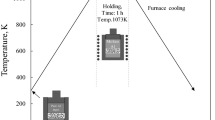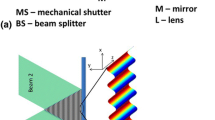Abstract
Sheet metals are extensively used in aerospace and automotive applications. The most desired properties of sheet metals are their excellent strength and formability. However, it is less common to have them simultaneously in sheet metals fabricated by conventional methods. Composite materials provide an excellent opportunity for fabricating components with tailored properties, with simple and predictable fabrication steps. The paper presents a detailed fabrication process of continuous fiber-reinforced sheet metals (aluminum matrix reinforced with stainless-steel fiber mesh) using the centrifugal casting technique. The stainless-steel fiber mesh is coated with copper through the electrodeposition method to achieve good wettability of aluminum with stainless steel. Characterization of the developed composite is performed using optical microscopy, scanning electron microscopy, and energy-dispersive X-ray spectroscopy. The analyses show defect-free microstructure with homogenous bonding between the aluminum matrix and stainless-steel fiber. Detrimental intermetallic compounds are not observed in the interface region. The tensile test reveals that the composite exhibits twice the strength of cast aluminum.
Access this chapter
Tax calculation will be finalised at checkout
Purchases are for personal use only
Similar content being viewed by others
References
Cassada W, Liu J, Staley J (2002) Aluminum alloys for aircraft structures. Adv Mater Process 160(12):27–29. https://doi.org/10.1533/9780857095152.173
Jawalkar CS, Kant S (2015) A review on use of aluminium alloys in aircraft components. i-Manager’s J Mater Sci 3(3):33–38. https://doi.org/10.26634/jms.3.3.3673
Ashjari M, Jodeiri Feizi A (2018) 7Xxx aluminum alloys; strengthening mechanisms and heat treatment: a review. Mater Sci Eng Int J 2(2):2–7. https://doi.org/10.15406/mseij.2018.02.00034
Liang G, Ali Y, You G, Zhang MX (2018) Effect of cooling rate on grain refinement of cast aluminium alloys. Materialia 3:113–121. https://doi.org/10.1016/j.mtla.2018.08.008
Wanhill RJH, Byrnes RT (2017) Stress corrosion cracking in aircraft structures, pp 387–410. https://doi.org/10.1007/978-981-10-2143-5_19
Shama Rao N, Simha TGA, Rao KP, GVV Ravi Kumar GVV (2018) Carbon composites are becoming competitive and cost effective. Infosys Ltd., pp 1–12 [Online]. Available: https://www.infosys.com/engineering-services/white-papers/Documents/carbon-composites-cost-effective.pdf
Giurgiutiu V (2016) Introduction. In: Structural health monitoring of aerospace composites, pp 1–23
Guha Keshav M, Hemchandran CG, Dharsan B, Pradhin K, Vaira Vignesh R, Govindaraju M (2020) Manufacturing of continuous fibre reinforced sintered brake pad and friction material. Mater Today Proc 10–13. https://doi.org/10.1016/j.matpr.2020.09.686
Govindaraju M et al (2020) Investigations on the tribological behavior of functionally gradient iron-based brake pad material. Proc Inst Mech Eng Part C J Mech Eng Sci 234(12):2474–2486. https://doi.org/10.1177/0954406220905858
Radhika N, Raghu R (2016) Development of functionally graded aluminium composites using centrifugal casting and influence of reinforcements on mechanical and wear properties. Trans Nonferrous Met Soc China (English Ed) 26(4):905–916. https://doi.org/10.1016/S1003-6326(16)64185-7
Radhika N, Karthik R, Gowtham S, Ramkumar S (2019) Synthesis of Cu-10Sn/SiC metal matrix composites and experimental investigation of its adhesive wear behaviour. SILICON 11(1):345–354. https://doi.org/10.1007/s12633-018-9848-6
Vaira Vignesh R, Padmanaban R, Govindaraju M, Suganya Priyadharshini G (2019) Mechanical properties and corrosion behaviour of AZ91D-HAP surface composites fabricated by friction stir processing. Mater Res Express 6(8). https://doi.org/10.1088/2053-1591/ab1ded
MMCs (2012) Metal matrix, fibre–metal and ceramic matrix composites for aerospace applications. In: Introduction to Aerospace Materials, pp 394–410. https://doi.org/10.1533/9780857095152.394
Huda D, Baradie MAE, Hashmi MSJ (1993) Metal-matrix composites : manufacturing aspects. Part I. J Mater Process Technol 37:513–528
Chirita G, Soares D, Silva FS (2008) Advantages of the centrifugal casting technique for the production of structural components with Al-Si alloys. Mater Des 29(1):20–27. https://doi.org/10.1016/j.matdes.2006.12.011
Agari SR, Mukunda PG, Rao SS, Sudhakar KG (2011) Inference of optimal speed for sound centrifugal casting of Al-12Si alloys. JOM 63(5):25–29. https://doi.org/10.1007/s11837-011-0071-9
Naik H, Gandhi M, Patel M, Prajapati R (2018) Effect of centrifugal force and speed in casting of aluminium alloy—a review. Int J Darshan Inst Eng Res Emerg Technol. ISSN: 2320-7590
Robin LG, Raghukandan K, Saravanan S (2021) Process parameter optimization to achieve higher impact strength in SS316 wire-mesh and SiCp reinforced aluminum composite laminates produced by explosive cladding. Met Mater Int 27(9):3493–3507. https://doi.org/10.1007/s12540-020-00641-9
Huang H, Wang J, Liu W (2017) Mechanical properties and reinforced mechanism of the stainless steel wire mesh-reinforced Al-matrix composite plate fabricated by twin-roll casting. Adv Mech Eng 9(6):1–9. https://doi.org/10.1177/1687814017716639
Pamula V, Kalyan KP, Vignesh RV, Govindaraju M (2021) Development and characterization of aluminum matrix composite reinforced with continuous stainless-steel fibres, Mater Today Proc. https://doi.org/10.1016/j.matpr.2020.12.201
Baron RP, Wert JA, Gerard DA, Wawner FE (1997) The processing and characterization of sintered metal-reinforced aluminium matrix composites. J Mater Sci 32(24):6435–6445. https://doi.org/10.1023/A:1018686505563
Bhagat RB (1989) Growth kinetics of interface intermetallic compounds in stainless steel fibre reinforced aluminium matrix composites. J Mater Sci 24(4):1496–1502. https://doi.org/10.1007/BF02397092
Chou TW, Kelly A, Okurat A (1985) Composites 16(3)
Mandal D, Dutta BK, Panigrahi SC (2008) Effect of copper and nickel coating on short steel fibre reinforcement on microstructure and mechanical properties of aluminium matrix composites. Mater Sci Eng 492:346–352. https://doi.org/10.1016/j.msea.2008.03.031
Jerold S, Chelladurai S, Arthanari R (2017) Effect of copper coating and reinforcement orientation on mechanical properties of LM6 aluminium alloy composites reinforced with steel mesh by squeeze casting. Trans Indian Inst Met. https://doi.org/10.1007/s12666-017-1235-2
Casanova T, Soto F, Eyraud M, Crousier J (1997) Hydrogen absorption during zinc plating on steel. Corros Sci 39(3):529–537. https://doi.org/10.1016/S0010-938X(97)86101-X
Paatsch W (2010) Hydrogen embrittlement in electroplating: avoidance using pulse plating. Trans Inst Met Finish 88(5):277–278. https://doi.org/10.1179/002029610X12791981507848
Author information
Authors and Affiliations
Corresponding author
Editor information
Editors and Affiliations
Appendix
Appendix
The present concept was conceived right around the time of the very first lockdown in March 2020. The luxury of utilizing resources was far at hand. Hence, almost all the apparatus required for experimentation were designed and constructed primarily at home, with most household parts or scrap materials. For example, mild steel pipe for die, motor from an old wet grinder, shaft from a ceiling fan, scrap plywood for the framework, old transformer and few electrical as a substitute for DC source was used in electrodeposition process. And the nichrome heating coil electrical resistance furnace was made of white cement and a metal bucket.
1 | Composite specimen |
|
2 | Centrifugal casting machine |
|
3 | Electric resistance furnace |
|
4 | Electroplating apparatus |
|
5 | Pulse generator circuit with 555 IC |
|
Rights and permissions
Copyright information
© 2023 The Author(s), under exclusive license to Springer Nature Singapore Pte Ltd.
About this paper
Cite this paper
Maruthiah, H. et al. (2023). Fabrication of Continuous Fiber-Reinforced Composite Sheet Metal Using Centrifugal Casting. In: Rajkumar, K., Jayamani, E., Ramkumar, P. (eds) Recent Advances in Materials Technologies. Lecture Notes in Mechanical Engineering. Springer, Singapore. https://doi.org/10.1007/978-981-19-3895-5_47
Download citation
DOI: https://doi.org/10.1007/978-981-19-3895-5_47
Published:
Publisher Name: Springer, Singapore
Print ISBN: 978-981-19-3894-8
Online ISBN: 978-981-19-3895-5
eBook Packages: EngineeringEngineering (R0)









